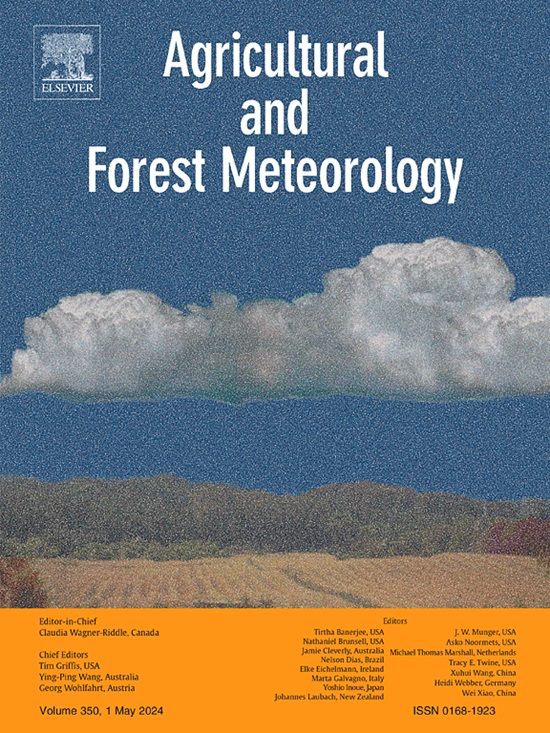Tropospheric ozone alters solar-induced chlorophyll fluorescence and its relationship with gross primary production in a subtropical evergreen forest
IF 5.7
1区 农林科学
Q1 AGRONOMY
引用次数: 0
Abstract
Tropospheric ozone (O3), as a harmful air pollutant and greenhouse gas, is globally increasing in concentration, raising concerns about its detrimental effects on ecosystems. To develop scientific strategies for protecting vegetation from O3 damage, a comprehensive understanding of vegetation responses to O3 is essential. Solar-induced chlorophyll fluorescence (SIF) offers a novel approach to studying how plants respond to stress, yet the extent and mechanism by which SIF reflects vegetation changes under varying ambient O3 remain unclear. Using continuous and simultaneous observations of O3, SIF, and carbon fluxes in a subtropical evergreen forest, we investigated the response of canopy SIF to ambient O3 exposure and explored the underlying mechanisms of vegetation’s response to O3. Our findings reveal that high ambient O3 alters both the canopy SIF and its relationship with GPP in the subtropical evergreen forest. Specifically, canopy SIF decreases when O3 concentrations exceed 60 ppb, but the threshold for a decrease in canopy SIF differs between the dry season (75 ppb) and the wet season (45 ppb), probably due to reduced stomatal conductance in the dry season, which limits O3 uptake by leaf. Furthermore, extremely high O3 concentrations decouple the linear SIF-GPP relationship (especially in wet season), indicating that high O3 exposure more strongly affects SIF and thus weakens the ability of SIF to track GPP dynamics. Our analysis of the decomposed radiative, structural, and physiological components shows that plant physiology is more vulnerable to O3 damage. This results in high O3 concentrations influencing the SIF-GPP relationship primarily through structure in the dry season and through plant physiology in the wet season. These findings highlight the ability of SIF for plant O3 stress detection and the different responses of structure and physiology under varying water conditions, which could effectively advance our understanding of plant O3 stress mechanisms across different climates.
对流层臭氧改变了亚热带常绿森林太阳诱导的叶绿素荧光及其与初级生产总量的关系
对流层臭氧(O3)作为一种有害的空气污染物和温室气体,其浓度在全球范围内不断增加,引起了人们对其对生态系统有害影响的关注。为了制定科学的保护植被免受O3损害的策略,全面了解植被对O3的响应至关重要。太阳诱导的叶绿素荧光(SIF)为研究植物如何应对胁迫提供了一种新的方法,但SIF在不同环境下反映植被变化的程度和机制尚不清楚。通过对亚热带常绿森林中O3、SIF和碳通量的连续观测,研究了林冠SIF对环境O3暴露的响应,并探讨了植被对O3响应的潜在机制。研究结果表明,高环境O3改变了亚热带常绿林冠层SIF及其与GPP的关系。具体来说,当O3浓度超过60 ppb时,冠层SIF降低,但冠层SIF降低的阈值在旱季(75 ppb)和雨季(45 ppb)之间有所不同,这可能是由于干旱季节气孔导度降低,限制了叶片对O3的吸收。此外,极高的O3浓度使SIF-GPP的线性关系脱钩(特别是在雨季),这表明高O3暴露对SIF的影响更强烈,从而削弱了SIF跟踪GPP动态的能力。我们对分解的辐射、结构和生理成分的分析表明,植物生理更容易受到O3的伤害。这导致高O3浓度主要通过旱季的结构和雨季的植物生理影响SIF-GPP关系。这些发现强调了SIF对植物O3胁迫的检测能力以及不同水分条件下植物结构和生理的不同响应,可以有效地促进我们对不同气候条件下植物O3胁迫机制的理解。
本文章由计算机程序翻译,如有差异,请以英文原文为准。
求助全文
约1分钟内获得全文
求助全文
来源期刊
CiteScore
10.30
自引率
9.70%
发文量
415
审稿时长
69 days
期刊介绍:
Agricultural and Forest Meteorology is an international journal for the publication of original articles and reviews on the inter-relationship between meteorology, agriculture, forestry, and natural ecosystems. Emphasis is on basic and applied scientific research relevant to practical problems in the field of plant and soil sciences, ecology and biogeochemistry as affected by weather as well as climate variability and change. Theoretical models should be tested against experimental data. Articles must appeal to an international audience. Special issues devoted to single topics are also published.
Typical topics include canopy micrometeorology (e.g. canopy radiation transfer, turbulence near the ground, evapotranspiration, energy balance, fluxes of trace gases), micrometeorological instrumentation (e.g., sensors for trace gases, flux measurement instruments, radiation measurement techniques), aerobiology (e.g. the dispersion of pollen, spores, insects and pesticides), biometeorology (e.g. the effect of weather and climate on plant distribution, crop yield, water-use efficiency, and plant phenology), forest-fire/weather interactions, and feedbacks from vegetation to weather and the climate system.

 求助内容:
求助内容: 应助结果提醒方式:
应助结果提醒方式:


